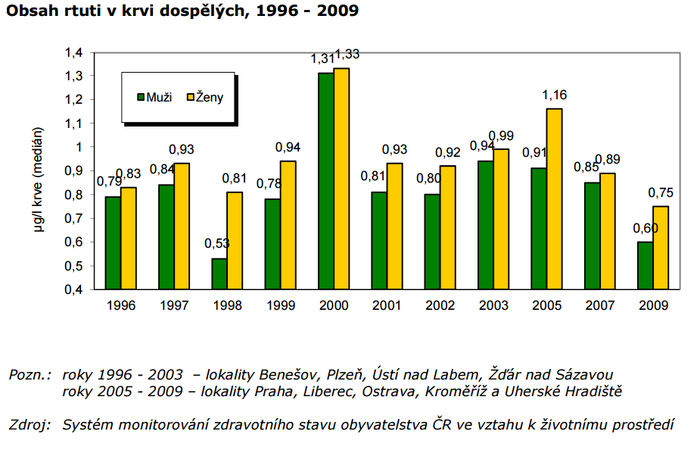Mercury in dental amalgams
Mercury is a significant toxic environmental contaminant. It exists in various forms: as elemental (metallic) mercury, inorganic and organic (eg methylmercury, which is formed by the conversion of metallic and inorganic forms of mercury by microorganisms, especially in water sediments).
- The metallic form of mercury damages the central and peripheral nervous system with chronic exposure, an effect on the immune system cannot be excluded either [1].
- Inorganic compounds cause kidney damage in particular.
- Methylmercury damages the central nervous system and is neurotoxic [2]. The neurotoxic effects of mercury are manifested by irritability, fatigue, impaired concentration, inability to relax, insomnia, tremors, motor and mental disorders (decrease in IQ) [3].
Mercury Exposure - Common[edit | edit source]
Possible routes of mercury intake for ordinary residents are inhalation of mercury vapor from the air and from amalgam dental fillings, intake of mercury from water and contaminated food. Of these sources of mercury exposure, the intake of toxic methylmercury through consumption of fish and fish products and inhalation of vapors and ingestion of small mercury particles from dental amalgam fillings is considered the most significant. According to estimates, amalgam fillings consume 55-95 tonnes of mercury per year across the EU, which corresponds to 20-25% of the total annual mercury consumption in the EU. The Czech Republic ranks 5th in the amount of mercury used for dental amalgam - an estimated 3.6 tons of mercury per year.
Mercury Exposure - Professional[edit | edit source]
Working with amalgam fillings is 'the most significant source of mercury for dental workers - dentists, instrument technicians, nurses. Inhalation or percutaneous exposure to mercury comes into consideration during the removal of old amalgam fillings and during their preparation, application and grinding. In addition to these standard actions, however, there remains the possibility of accidental contamination of the office environment during defective handling of dental amalgam [4].
Health risks[edit | edit source]
Mercury belongs to toxic heavy metals. It is widely distributed in the environment, has the ability to accumulate in living organisms and be transmitted further through the food chain. Mercury has a number of negative effects on the body, one of the most serious proven effects is damage to the nervous system. The risk group is especially pregnant women, due to the possibility of impairment of fetal development and the development of neuropsychiatric disorders in children [5]. Mercury concentration in the blood is an indicator of recent exposure, it relates mainly to the most health-threatening organic forms of mercury (methylmercury). The content in the urine is a reflection of the long-term burden of the organism, especially mercury vapor and its inorganic forms.
'Hazardous waste according to Directive 91/689/EEC
....
....
18 01 10* Waste amalgam from dental care
....
....
Links[edit | edit source]
Related Articles[edit | edit source]
- Amalgam
- History of Direct Dental Fillings
- Heavy metal poisoning
- Intoxication by mercury and its compounds
External links[edit | edit source]
References[edit | edit source]
- ↑ VITALE, Arthur. AdsFlick [online]. 12/10/2009 [cit. 2012]. WHO, 2000 - Air quality guidelines - second edition, WHO Regional Office for Europe, Copenhagen, Denmark, 2000.
- ↑ ATSDR, Toxicological profile for mercury, 1999; <https://www.atsdr.cdc.gov/toxprofiles/tp46.html>.
- ↑ IPCS (2003) Elemental mercury and inorganic mercury compounds: human health aspects. Geneva, World Health Organization, International Program on Chemical Safety (Concise International Chemical Assessment Document 50).
- ↑ Tuček M., Bencko V., Krýsl S. (2007): Health risks of mercury from dental amalgams. Chem. Letters 101: 1038–1044.
- ↑ Bencko, V., Cikrt, M., Lener, J.: Toxic metals in life and a person's work environment. Grada Publishing, 1995, 282 pages. ISBN 80-7169-150-X.
- ↑ Státní zdravotní ústav (2013), Systém monitorování zdravotního stavu obyvatelstva České republiky ve vztahu k životnímu prostředí (Obsah rtuti v krvi a moči), 1. vydání / 1st edition, 90. ISBN 80-7071-074-6

